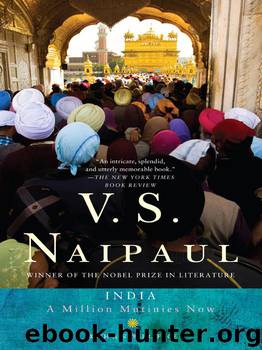India: A Million Mutinies Now by V.S. Naipaul

Author:V.S. Naipaul
Language: eng
Format: mobi, epub
Tags: India & South Asia, Asia, History
ISBN: 9780307742780
Publisher: Knopf Doubleday Publishing Group
Published: 2011-03-22T00:00:00+00:00
5
After the Battle
In India in 1962 I took much of the British architecture for granted. After what I had known in Trinidad and England, British building in India seemed familiar, not a cause for wonder. Perhaps, too, in 1962, just 15 years after independence, I didn’t allow myself to see British Indian architecture except as background. I was saving my wonder for the creations of the Indian past. Even Lutyens’s great achievement in New Delhi I saw in a grudging way, finding the scale too grand, looking in his ceremonial buildings for the motifs he had got from the Mogul builders, and finding in his adaptations further evidence of vainglory.
I looked in this partial way even at the lesser architecture of the British, the bungalows and houses built for officials in the country districts. They were pleasant to stay in; with their porticoes and verandahs, thick walls, high ceilings, and sometimes additional upper windows or wall-openings, they were well suited to the climate. But they seemed too grand for the poverty of the Indian countryside. They seemed also to exaggerate the hardships of the Indian climate. So that, though absolutely of India, these British buildings, by their exaggeration, seemed to keep India at a distance.
But the years race on; new ways of feeling and looking can come to one. Indians have been building in free India for 40 years, and what has been put up in that time makes it easier to look at what went before. In free India Indians have built like people without a tradition; they have for the most part done mechanical, surface imitations of the international style. What is not easy to understand is that, unlike the British, Indians have not really built for the Indian climate. They have been too obsessed with imitating the modern; and much of what has been done in this way – the dull, four-square towers of Bombay, packed far too close together; the concrete nonentity of Lucknow and Madras and the residential colonies of New Delhi – can only make hard tropical lives harder and hotter.
Far from extending people’s ideas of beauty and grandeur and human possibility – uplifting ideas which very poor people may need more than rich people – much of the architecture of free India has become part of the ugliness and crowd and increasing physical oppression of India. Bad architecture in a poor tropical city is more than an aesthetic matter. It spoils people’s day-to-day lives; it wears down their nerves; it generates rages that can flow into many different channels.
This Indian architecture, more disdainful of the people it serves than British Indian architecture ever was, now makes the most matter-of-fact Public Works Department bungalow of the British time seem like a complete architectural thought. And if one goes on from there, and considers the range of British building in India, the time span, the varied styles of those two centuries, the developing functions (railway stations, the Victoria Memorial in Calcutta, the Gateway of India
Download
India: A Million Mutinies Now by V.S. Naipaul.epub
This site does not store any files on its server. We only index and link to content provided by other sites. Please contact the content providers to delete copyright contents if any and email us, we'll remove relevant links or contents immediately.
How to Read Water: Clues and Patterns from Puddles to the Sea (Natural Navigation) by Tristan Gooley(2849)
Full Circle by Michael Palin(2764)
Into Thin Air by Jon Krakauer(2695)
How to Read Nature by Tristan Gooley(2657)
The Lost Art of Reading Nature's Signs by Tristan Gooley(2281)
In Patagonia by Bruce Chatwin(2262)
Don't Sleep, There Are Snakes by Daniel L. Everett(2212)
City of Djinns: a year in Delhi by William Dalrymple(2130)
L'Appart by David Lebovitz(2113)
The Songlines by Bruce Chatwin(2108)
Venice by Jan Morris(2046)
The Big Twitch by Sean Dooley(2041)
A Thousand Splendid Suns by Khaled Hosseini(1983)
Tokyo Geek's Guide: Manga, Anime, Gaming, Cosplay, Toys, Idols & More - The Ultimate Guide to Japan's Otaku Culture by Simone Gianni(1941)
A TIME OF GIFTS by Patrick Leigh Fermor(1844)
Come, Tell Me How You Live by Mallowan Agatha Christie(1764)
The Queen of Nothing by Holly Black(1748)
INTO THE WILD by Jon Krakauer(1719)
Iranian Rappers And Persian Porn by Maslin Jamie(1706)
